
Hazardous Area Oxymitter DR
Instruction Manual
1
SECTION 1
DESCRIPTION AND SPECIFICATIONS
1-1 COMPONENT CHECKLIST OF TYPICAL
SYSTEM (PACKAGE CONTENTS)
A typical Rosemount Hazardous Area Oxymitter DR
The Oxymitter DR is offered in both hazardous and general purpose con- figurations. The hazardous area ver- sion has the “EX” and CSA symbols on the apparatus approval label. The general purpose version does not have an approval label. If you received the general purpose version, ensure you do not install it in a potentially ex- plosive atmosphere.
Also, use the product matrix in Table
1-2 SYSTEM OVERVIEW
a.Scope
This Instruction Bulletin is designed to supply details needed to install, start up, operate, and maintain the Hazardous Area Oxymitter DR. The Hazardous Area Direct Replace- ment Oxymitter can be interfaced to a num- ber of different earlier model electronics packages. These electronic packages are not covered in this manual. For specification information concerning calibration and op- eration of the system, refer to the Instruction Bulletin applicable to your electronics.
b.System Description
The Hazardous Area Oxymitter DR is de- signed to measure the net concentration of oxygen in an industrial combustion process; i.e., the oxygen remaining after all fuels have been oxidized. The probe is permanently po- sitioned within an exhaust duct or stack and performs its task without the use of a sam- pling system.
The equipment measures oxygen percent- age by reading the voltage developed across a heated electrochemical cell, which consists of a small
EMF = KT log10(P1/P2) + C
Where:
1.P2 is the partial pressure of the oxygen in the measured gas on one side of the cell.
2.P1 is the partial pressure of the oxygen in the reference air on the opposite side of the cell.
3.T is the absolute temperature.
4.C is the cell constant.
5.K is an arithmetic constant.
When the cell is at operating temperature and there are unequal oxygen concentra- tions across the cell, oxygen ions will travel from the high oxygen partial pressure side to the low oxygen partial pressure side of the cell. The resulting logarithmic output voltage is approximately 50 mV per decade. The output is proportional to the inverse logarithm of the oxygen concentration. Therefore, the output signal increases as the oxygen con- centration of the sample gas decreases. This characteristic enables the Hazardous Area Oxymitter DR to provide exceptional sensi- tivity at low oxygen concentrations.
Rosemount Analytical Inc. A Division of Emerson Process Management | Description and Specifications |
